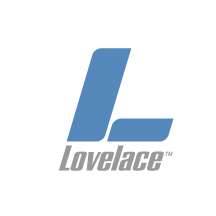Lovelace Respiratory Research Institute
 | |
| Established | 1947 |
|---|---|
| Research type | Respiratory Disease |
| Budget | US$65 million[1] |
| Staff | 83 PhD level scientists, 539 technicians and support staff |
| Location | Albuquerque, New Mexico |
| Campus | 500,000 square feet |
Operating agency | Lovelace Respiratory Research Institute |
| Website | www.lrri.org |
The Lovelace Respiratory Research Institute (LRRI) is a private not-for-profit biomedical research organization dedicated to improving public health through research into the prevention, treatment and cure of respiratory disease.[2] LRRI employs over 500 staff in New Mexico and in 2008 is spending more than $60 million in the fight against respiratory diseases such as asthma, emphysema, lung cancer, bronchitis and allergies.[3] LRRI currently has two main locations, both located in Albuquerque, New Mexico. Most of LRRI's funding comes from United States government and private grants.[4][5]
History
The Lovelace Respiratory Research Institute traces its roots to the arrival of Dr. William Randolph Lovelace I to Sunnyside-Fort Sumner New Mexico in 1906 as a company physician for the Santa Fe Railroad and a construction project with the Lantry Sharp Construction Company. He sought the Southwest due to his contraction of tuberculosis. Living in a dry, sunny climate was a recommended therapy in the pre-antibiotic era. In 1908, his extended family, including his brother Edgar (who pursued a successful career as a rancher) and Edgar's infant son, William Randolph Lovelace II, moved to New Mexico. In part resulting from his frustration with the limited medical capabilities of his rural practice and in part through discussions at medical meetings with Drs. Will and Charlie Mayo who established the Mayo Clinic), Dr. Lovelace formed the dream of developing a multispecialty clinical center. By the time New Mexico became a state in 1912, Albuquerque had become the new state's largest city. In 1913, Dr. Lovelace moved to Albuquerque and established a successful private practice. The Lovelace Clinic became the Southwest's first center of specialty medicine, specifically treatment of tuberculosis.[6]
The nephew of Dr. Lovelace, William Randolph Lovelace II (Randy), pursued a career in medicine and received his M.D. from Harvard University in 1934. Due to his prowess as a surgeon, Randy was appointed Chief of Surgery within a few years of the commencement of his fellowship with Mayo Clinic. The polio outbreak of the 1940s had a devastating effect on Randy's life, with his two sons succumbing to the disease in 1946. Randy and his wife moved back to Albuquerque, where the older Dr. Lovelace asked him to join his specialty clinic. Randy agreed to join him on the condition that the clinic expand to the three-part mission of health care, research, and education. The nonprofit Lovelace Foundation for Medical Education and Research was thus formed. Through grants from the United States government agencies and private companies alike, multiple properties were purchased in the Southeast corner of Albuquerque, one of which is currently the site of LRRI's North Campus.
The Lockheed U-2 pilots were sent to the Lovelace Clinic for a week-long physical examination. "Many of the tests which we pioneered were later made a part of the astronaut's physicals."[7] In 1959, the Lovelace Clinic was the place where 32 candidate pilots were tested under a contract to NASA through a seven-day series of rigorous psychological and physiological tests. Out of this pool of candidates the seven Project Mercury astronauts were selected.
Over the years, the Foundation's research expanded into additional fields, such as the study of the effects from inhalation of radioactive particles. Inside Kirtland Air Force Base, the Fission Product Inhalation Laboratory was constructed in 1964. FPIL quickly became one of the world's foremost centers for the study of inhalation toxicology. In the 1970s, the facility was expanded to study the inhalation of non-radioactive materials, and renamed the Inhalation Toxicology Research Institute (ITRI). ITRI eventually became the Lovelace Respiratory Research Institute (LRRI) in 1996.
Currently, LRRI is the nation's largest independent, not-for-profit organization conducting basic and applied research on the causes and treatments of respiratory illness and disease.[8]
Mission
The mission of LRRI is to serve humanity through research on the prevention, treatment, and cure of respiratory disease.[1]
See also
References
- 1 2 Corporate Website
- ↑ http://www.reuters.com/article/pressRelease/idUS236285+04-Mar-2009+PRN20090304
- ↑ http://www.ibtimes.com/prnews/20081113/lovelace-respiratory-research-institute-switches-to-provantis-preclinical-solution.htm
- ↑ http://www.accessmylibrary.com/coms2/summary_0286-33146946_ITM
- ↑ http://www.accessmylibrary.com/coms2/summary_0286-32982614_ITM
- ↑ Spidle, Lovelace, pp. 5-17
- ↑ Powers, Francis (1960). Operation Overflight: A Memoir of the U-2 Incident. Potomac Books, Inc. p. 13,16,46. ISBN 9781574884227.
- ↑ http://www.lrri.org
External links
- Lovelace Respiratory Research Institute Repository. Contains historical photos and papers.
- LRRI Corporate Website.
- Breathe; a publication of the Lovelace Respiratory Research Institute http://www.lrri.org/DPage.aspx?p=90
- Corporate Website. http://www.lrri.org/
- Corporate Website "About Us" http://www.lrri.org/AboutLRRI.aspx
- Spidle, Jake W. The Lovelace Medical Center. University of New Mexico Press, 1987. ISBN 0-8263-1007-9